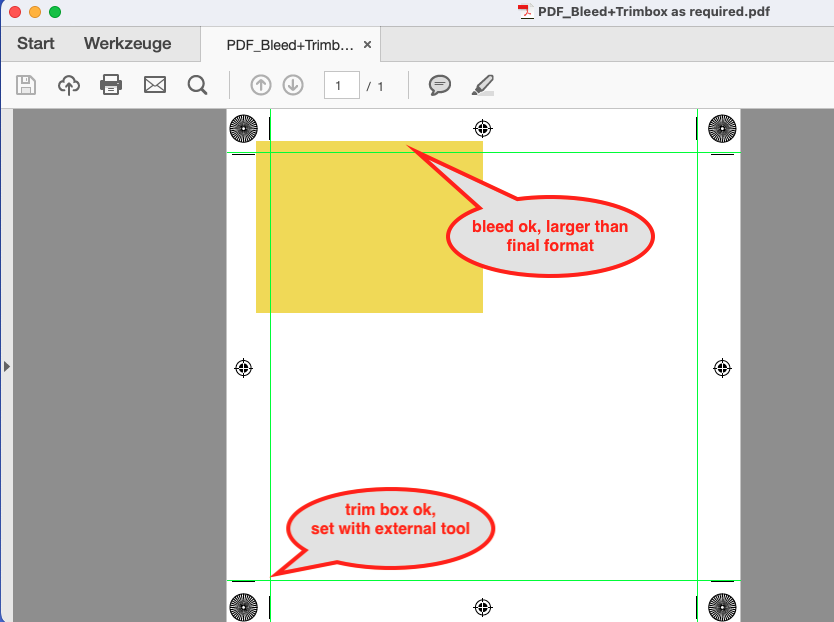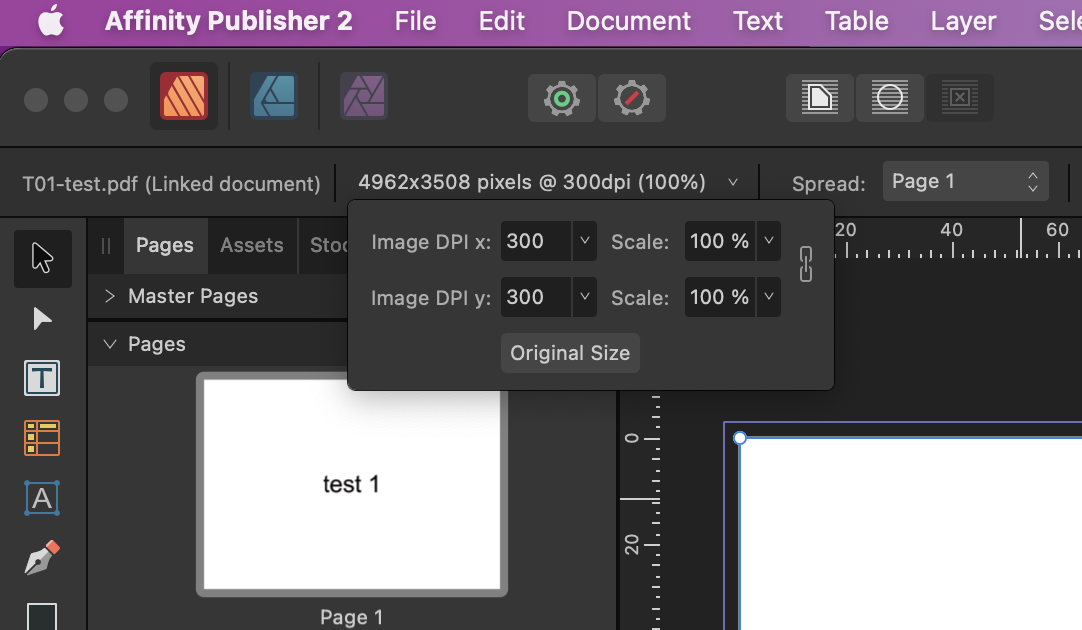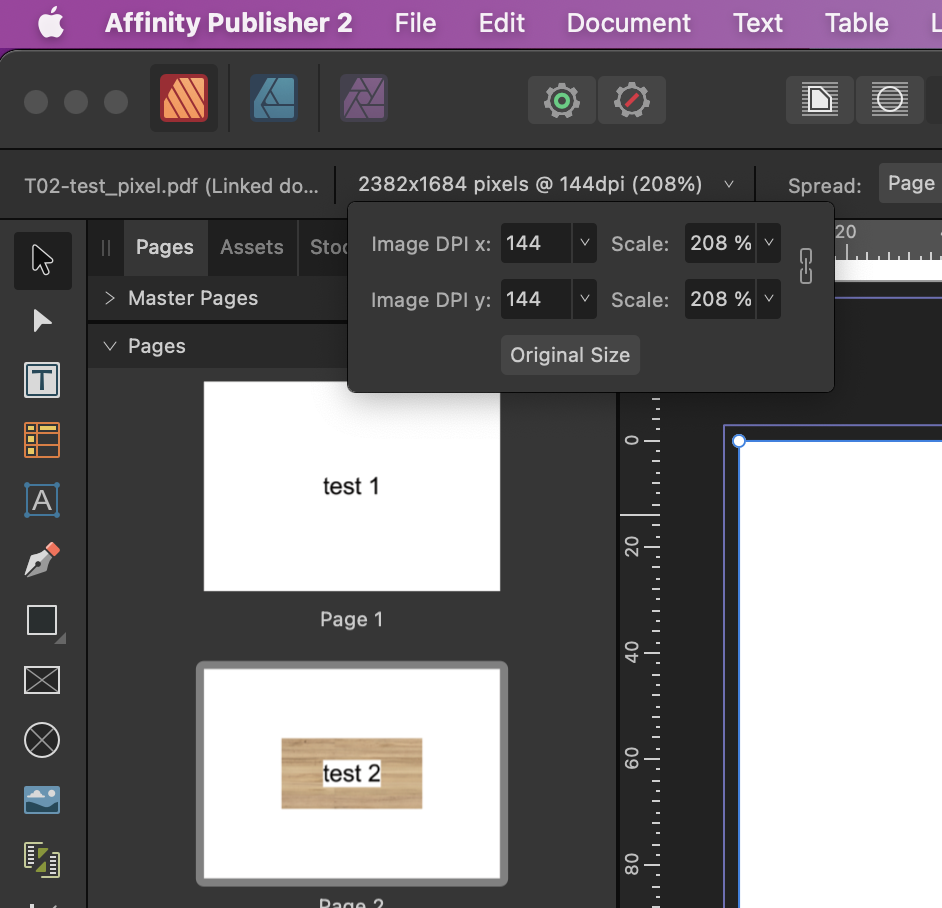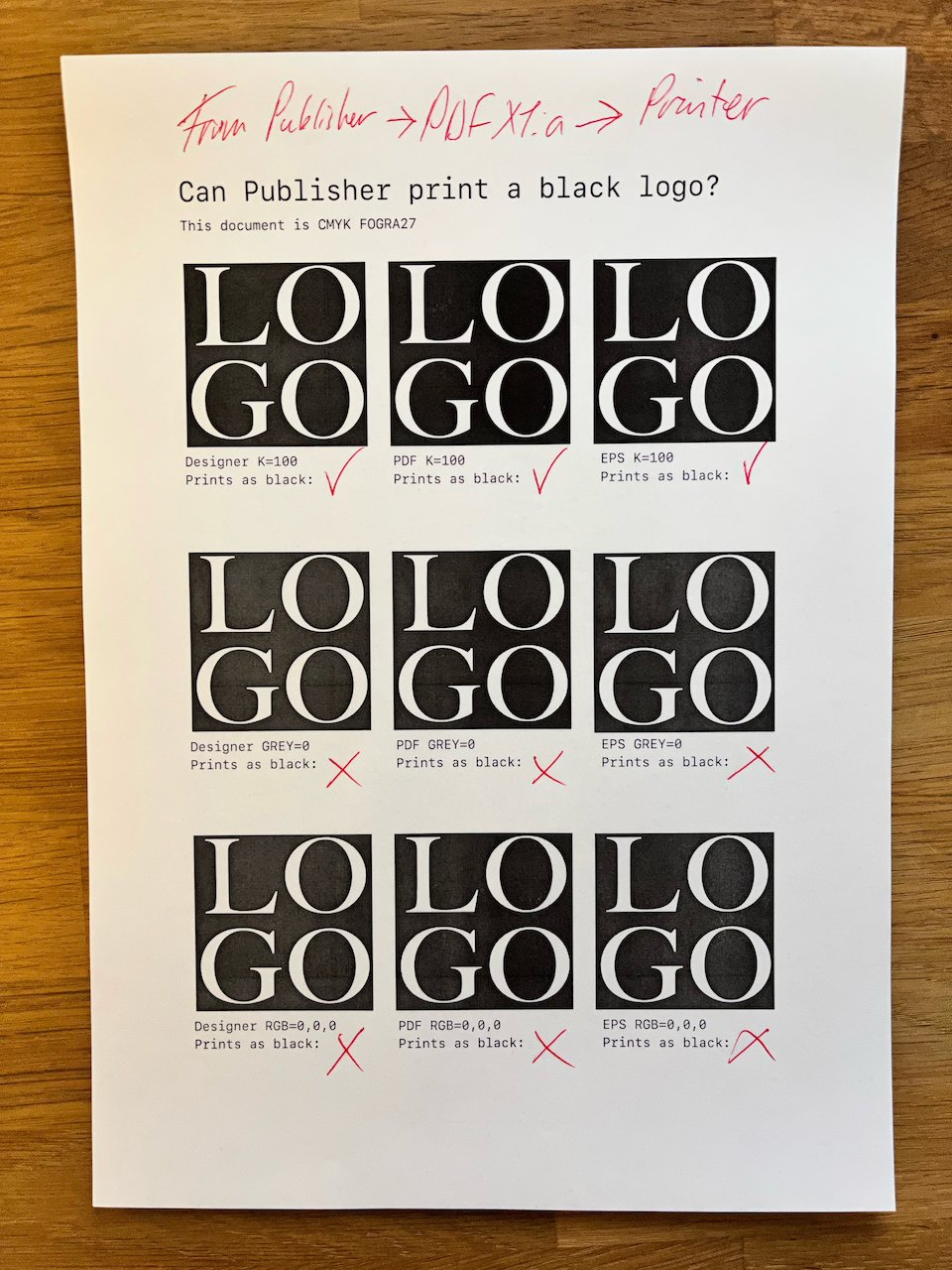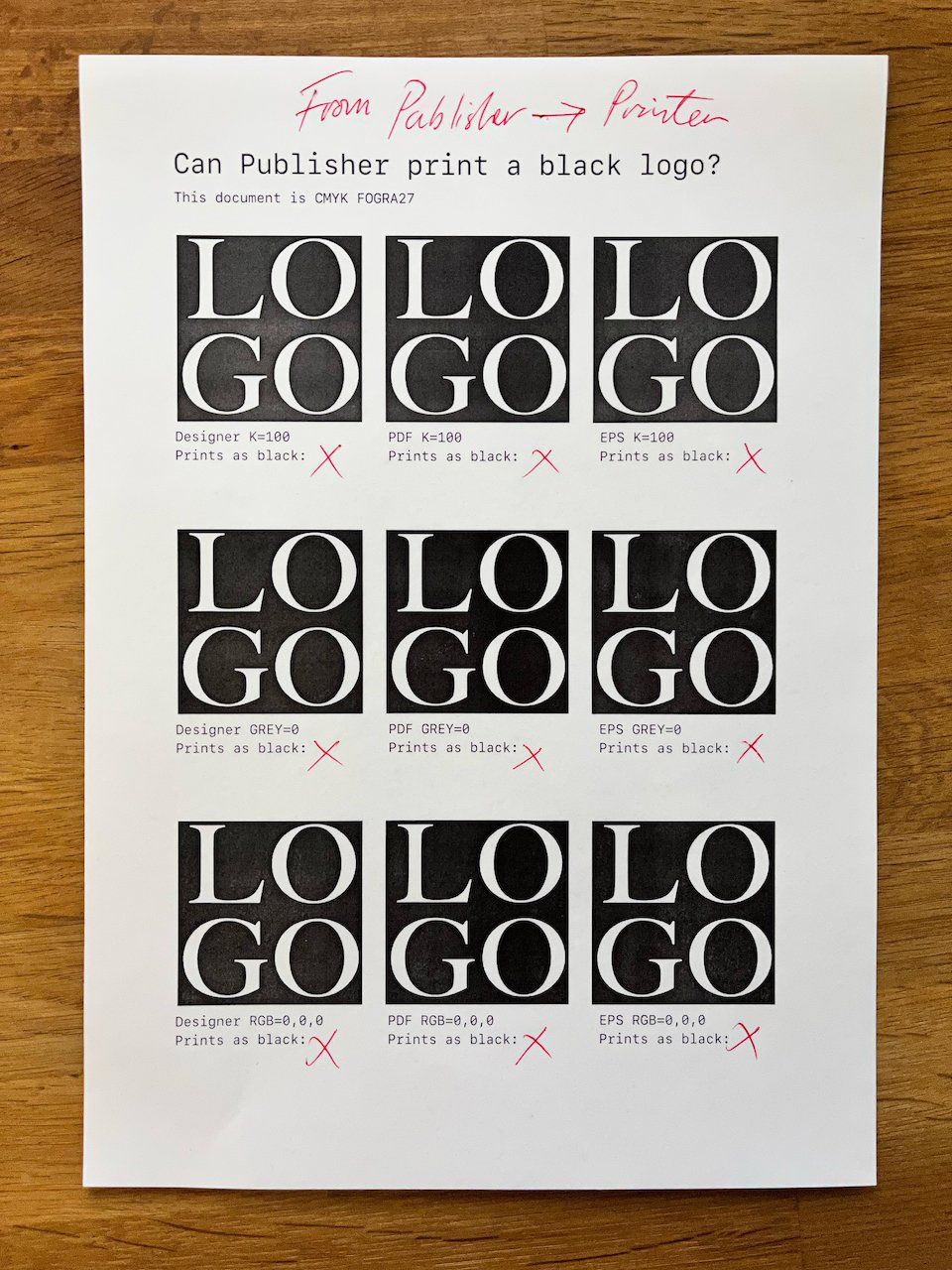Search the Community
Showing results for tags 'PDF'.
-
Hey guys, Data Merge is a really nice feature of Affinity Publisher, but unfortunately it doesn't support linking text content using the URL that is in the CSV. It would be wonderful to have this feature working, mainly because not even Acrobat Reader can do it at the moment, you would be at the forefront once again with such an amazing feature.
- 9 replies
-
- affinity publisher
-
(and 3 more)
Tagged with:
-
Hello, I am building my CV/Resume in Publisher and when exported as a PDF, it doesn't seem to matter which format I choose (Print, Digital, for export…) or the compatibility version (1.7, 1.6, 1.4…), once loaded into an applicant tracking software (ATS) scanner, like https://cultivatedculture.com/resume-scanner/ for instance, the text is not properly extracted and so the match between my CV and the job offer is pretty low (of course). The only reason that I found could be that the encoding software used by Affinity is incompatible, somehow, with this ATS technology. Indeed, once I upload my Affinity PDF into PDF Reader Pro Lite and save it as another PDF, the encoding software in the file info (cmd+i) changes from "PDFlib+PDI 9.2.1-j (macOS (x86_64))" for the Affinity file to "macOS version 12.6.1 (Build 21G217) Quartz PDFContext" for the PDF Reader Pro Lite file, which is read by the ATS scanner. The "Version" in the file info also changes from 1.7 to 1.4; but as I said, it doesn't matter as I've also tried to export it as a 1.4 file with Affinity Publisher to no more success. Does anyone know why this happens, if there is a way to fix this in Affinity, and if Serif is aware of this problem? P.S.: I attach the files in case people want to dig this issue. CV_PERRIER_Mickael_AlternanceUX [Affinity].pdf CV_PERRIER_Mickael_AlternanceUX [PDF Reader Pro Lite].pdf
- 1 reply
-
- affinity publisher
-
(and 5 more)
Tagged with:
-
Hi, I seem to have run into an issue where Affinity Designer selects objects that are not within the selection window. This happens with both selection tools: 2023-03-10 09-25-50.mp4 You can see that objects were added even though I am not touching the object and I am even outside its bounding box. 2023-03-10 09-26-33.mp4 This is a file that I exported as PDF from Rhino. Buggy selection.afdesign Windows 10.0.19045, Affinity Designer 2.0.4.
-
Briss has been a wonderful tool for Windows and open-source OS systems to trim off excess white spaces surrounding some published PDF documents. Is there any way to do global trimming? Or is there a convoluted method involving defining new Master page resizing, etc. ? On the Briss tool (last version 0.9) one could drag corners to desired proportions for Left and Right pages and it is done on requesting a crop. It automatically appends a suffix "_crop" to output filename if required.
-
Since the last days I am losing all my printing (directly to my L14150 EPSON printer or "Windows Print to PDF"). All imagens with transparence backgraound started to lose the transparence or bright changing, as shown below: There is no filter, transformation, FX, mask (...) applied. Just a PNG over other image. Everything was working fine untill few days ago. What is happening? If I do the same art using Corel, the correct result os obtained: I am using Affinity V 2.0.4 and tryed to chance de color profile several times. Its an Affinity bug, definitely. Is anyone having the same bug?
- 10 replies
-
Situation: Heidelberg Signa Station (and i guess any imposition tool) is using the PDFs trimbox as positioning default. This requires - a trim box sized like the desired final format - a bleed value larger than the trim box. Affinity Problem: If the PDF export of Designer and Publisher is set to „include Bleed“ , the trim box equal to the bleed box. See Screenshots and PDF files: 1. PDFExport_Bleed included Bleed ok to aviod cut problems. Problem: Trim box is set to 100mm +3mm. This PDF cannot be placed by industrial workflows or automatted imposition software. 2. PDFExport_BleedNOTincluded Trim box ok, 100x100 mm like final format. Problem: No bleed available 3. PDF_Bleed+Trimbox as required Affinity Designer and Publisher 2.0.4 Mac or Windows doesn’t matter Reproducable. PDF_Bleed+Trimbox as required.pdf PDFExport_BleedIncluded.pdf PDFExport_BleedNOTincluded.pdf
- 3 replies
-
- imposition
- printproduction
-
(and 1 more)
Tagged with:
-
The following issue, I'm not sure if it's MY mistake or a bug in Affinity Publisher: I have a logo consisting of an SVG vector file. I modified it as a vector in Affinity Designer. Now I embed this file in an Affinity Publisher document. (For testing purposes, I also created a link instead of embedding it) - when I look at the document in Publisher, I don't see any staircases or artifacts. In addition, I put a font under the logo. If I now export the whole thing with the PRINT-READY Pdf Preset, I get a PDF in which the font under the logo is razor sharp, but the logo itself looks very pixelated - like a bitmap! A mistake in the publisher? Or user error? Here are the files so you can take a look, along with the resulting PDFs.test_vector_pixel_verknuepft.afpub test_vector_pixel.afpub test_vector_pixel_verknuepft.pdf test_vector_pixel.pdf test_vector_pixel_verknuepft.afpub TEST_LOGO_black.afdesign
- 4 replies
-
- affinity publisher
- vector
-
(and 3 more)
Tagged with:
-
I am using the Affinity Publisher 2.0.4 on a MacBook pro OS 12.6.3. When I export a doc to a PDF, then try to copy text from the PDF it looks like this: "These are fun exercises to prac�ce spo�ng strengths. Please use the strength spo�ng sheet on the last page for this ac�vity and provide a copy for everyone who is par�cipa�ng." The problem exists in the previous version of Affinity as well. Please fix. Thanks.
-
Hi, I bought recently AFP 2.0. I am still using Monterey OS (I will install it when it is more stable). I have problems when trying to export any publisher document to PDF. I have never gone beyond a 10 spread document, as I need to test how it looks (the file size has ranged between 150 and 400 MB). I started using embedded files and then I swapped to linked files. I converted all my psd or jpg files to Affinity Photo 2 format, in case that was the problem. It makes no difference if it is RGB or CMYK, they both crash. It doesn't matter if I try to make a copy of the file and rename it, it won't stay open (the problem persists even if I close the program and restart the computer). Through the different releases I keep having the same problem. I am not sure what is happening. I manage to export to a PDF, but it is impossible to keep working on my original publisher file, crash, after crash, not even the time to save to a different file. Could you please help me to figure out how to solve the problem? I attach the beginning of the latest problem report. Thank you. Clemencia
- 2 replies
-
- affinity publisher 2
- crash
-
(and 2 more)
Tagged with:
-
When you data merge a PDF file into a Picture Frame, it automatically gets placed with "Page Box: Trim Box" setting, which cuts off all bleed area, making any files with Trim Box defined unusable for data merge purposes. There needs to be a setting allowing you to choose the type of a PDF box in data merge settings, or if should be placed with either "Bleed" or "Crop" boxes selected instead.
-
- data merge
-
(and 1 more)
Tagged with:
-
If I create a picture frame and then attempt to data merge a PDF into it, the scaling option of the picture frame will be ignored - if scaling: "None" is selected, merged PDF will still be scaled to something other than 100% and placed at the wrong size. This only seems to happen with data merge, when placing a PDF into Picture Frame manually the scaling option is respected.
- 1 reply
-
- picture frame
-
(and 2 more)
Tagged with:
-
I tried to do the following: Create a 2-page document 90x50mm Create 2 master pages, on each page place one PDF page to serve as the static content, apply them to respective regular pages. PDF file size is 2.5MB Create a single text field on one of the pages, link it to a data field from a spreadsheet, this will be the only dynamic content present, 2000 records total Data merge -> create merged document, goes fast enough, under 10 seconds Export as PDF -> the export process didn't even move past 25% after 5 minutes. This is completely insane, as the only variable element is a single text field, it should be done in seconds. It also eats enormous amounts of disk space, dozens of gigabytes. At around 33% I ran out of disk space, and the job processing was cancelled with an error. PersonaBackstore.dat was 34 GB at the time the disk ran out of space. Seems like its trying to re-print the background from the linked PDF for every single record, rather than once. _____________________ I did the exact same steps in Adobe IdDesign CS5, and export to PDF for all 2000 records took 15 seconds. No additional disk space was consumed, barely any RAM was used. Same export settings. Didn't need to create the merged file too, export directly to PDF.
- 33 replies
-
- data merge
- export
-
(and 1 more)
Tagged with:
-
I'm using Publisher 2 (v 2.0.3) on macOS 12.6.2., Intel Macbook Pro 2019, hardware acceleration is turned on. Publisher shows the the size and scaling of placed PDF-files in pixels and dpi (this is the first mistake) in the upper left corner. The little dropdown offers a button "original size" to set back any scaling to 100%. Even though it doesn't make any sense to show the size of PDFs (only) in pixels, the scaling in percent and the button "original size" are very usefull and absolutely indispensable when working with true to scale plans. While the whole thing seems to work ok with PDFs that are vector based only, it breaks completely once there are pixel based elements in the placed PDF file. For some reason Publisher then estimates a wrong size of the PDF. Strangely enough, when placing the file it is shown and placed in the right size, but the scaling already shows a wrong percentage (of course it should 100% right after placing a new file). Pressing the button "original size" causes the placed file to get a wrong scaling, making it impossible to go back to the original scaling of placed documents. As I said, it is essential when e.g. working with true to scale plans or something similar, to be able to controll the scaling of placed documents. The size of PDFs should never be shown in pixels only, since any PDF file has proper physical dimensions, that should be shown in whatever document units are set to (e.g. mm, inch...). Pressing the button "original size" should of course set the scaling to the original size. Please fix this! I think there is already a post about the same problem, but since it only describes the case of replacing PDFs but not the general problem with the scaling of any placed PDF I decided to open new topic. pdf_test.zip
- 9 replies
-
- affinity publisher
-
(and 2 more)
Tagged with:
-
no matter what i do i get no pdf or eps preview thumbnail from designer or photo when exported from either software. This works fine for me form illustrator and photoshop. I have no issues with seeing a thumbnail in the browser if saved or exported from illustrator or photoshop to eps or pdf. Ideas or thoughts.
-
I have to modify a PDF where I can reorganize sections of a music PDF. The music comes through just fine, as well as most of the text. However the vocal lines have the weirdest letter spacing I have seen. Publisher imports text with tabs in the middle of the lyrics. The lyrics are in Times New Roman, so its not a case of me not having the right font on my computer. InDesign and Acrobat Pro can open it just fine, as well as several other files. I certainly am puzzled by this behaviour. I'm pulling the plug on Adobe the middle of January, and would really like to sort this out. I don't modify music very often at all, but this gives me pause with Affinity's relationship with PDFs. Excerpt- Acrobat-On Eagle's Wings - Eb Major.pdf
-
If you're having issues exporting to PDF, you may be advised by the Support team to enable PDFLogging. This will allow our developers to look into your issue further and hopefully figure out what's causing the issue. For Windows: Create a folder called temp on the root of your C:\ drive so you have folder at C:\Temp\ Run PDFLibLogging.reg - this will create a registry entry that enables logging for PDF Export Run Affinity and export to PDF and then click OK to accept the error message. Go to C:\Temp\ and send the newly created PDFlib.txt file to the support team as requested Now run PDFLibLoggingRemove.reg to return your settings back to normal PDFLibLogging.reg PDFLibLoggingRemove.reg
- 1 reply
-
- affinity v2 suite
-
(and 1 more)
Tagged with:
-
Hello, I have searched the fora (and internet at large) and found mentions of similar difficulties, but unfortunately none of the answers seemed to quite work for me. I am new at this so maybe I just don't quite understand everything correctly. I have created a very graphics heavy book in Affinity Publisher that I am trying to have printed through Barnes and Noble Press. Of note: if anyone else is trying to do this, set your document to 1/4" smaller on both dimensions than your desired finished dimensions. I have no idea why, but if you don't, B&N's system will reject it. I learned this through trial and error. Anyway, most of the book interior consists of text boxes laid on top of background pictures, and of course the cover does too. It looks perfect in Affinity, and it exports to a PDF just fine on my computer. However, when I upload it to B&N's system and download it as a digital proof, tiny thin white/grey lines appear around the text areas. I am concerned these lines will show up when the books are printed. How can I get rid of these lines? They look AWFUL, and seem to appear everywhere or almost everywhere text is on top of a background image. Below is a zoomed in example. What's especially interesting about this spot is that I used the 'text on a path' feature here - you can see that the text is on an arc bending upward, and those little faint lines are still there, but they are rectilinear! What gives?? Thank you in advance!
- 1 reply
-
- affinity publisher
-
(and 3 more)
Tagged with:
-
Hi I am trying to export a 24pp brochure to PDF with bleed area and cut lines in CMYK. But every time it comes up with a pop up saying an error occurred unable to export. I have also tried exporting locally, same problem, or the program crashes. I really need your help the document needs to be submitted tomorrow. many thanks
-
When a manual is in .PDF form, I can simply read one page after another, till I get to the end, and know I have read the entire manual. HTML-based manuals force me to navigate a maze of links, hoping beyond hope that I have successfully found every page. Even with a navigation bar on the side, one cannot be sure that every single page is linked to in said navigation bar. Many, many HTML-based manuals end up with sub-pages that can only be found via an obscure link, buried in a paragraph somewhere. So, you are forced to click every link you see, out of fear of missing out. This makes reading a manual kind of exhausting. In a .PDF, I can annotate the document as I see fit. I can highlight important parts. I can insert any questions I may have while reading (even when away from my main computer). Then, I can go back and try to answer those questions when I am either at my main computer or when I am online. Plus, sometimes you just want to insert a question and then keep reading. With HTML-based help, you have to use a separate method to keep track of all these notes and questions. It then becomes extra tedious to keep track of which note or question is about which part of the manual. I can synchronize a .PDF manual (along with all those annotations) between different devices, simply by storing it in some cloud-based service. Yes, I can sometimes save "favorites" or "bookmarks" in an HTML-based help system, but those can never be synchronized between all my devices. So, if I want to make use of that feature, I am forced to always read said help on a single device. Without these abilities, reading HTML-based help can become extremely frustrating. Especially when said "help" glosses over most of the actual detail of how to use the program. As a former network manager, and a former technical writer, with a degree in Computer Science and Education, I can definitely tell the difference between me simply not being able to understand something and just poor documentation. I do have the tools available to convert existing HTML-based manuals to PDF. But it can be a tedious and error prone process. And the whole process must be repeated each time the HTML-based manual is updated. It is always far better to just start from the source files and use a reliable utility to produce the .PDF version of the document. Usually, the same tool that generated the HTML-based manual has a feature to generate a .PDF file as well. So there is often no real excuse for a company to neglect doing this. Sometimes it feels as if software companies rely solely on HTML-based documentation just so they never have to worry about users working from an outdated copy of the manual. But I also feel that this is a bit of a cop-out.
-
I’m suddenly getting this kind of error when exporting to PDF. This didn’t happen in my previous exports. Used the same fonts as I did before. Had no errors in preflight aside from spelling corrections and bleed warnings before exporting. Weird thing is that this error does not happen when I’m using the Print option.
- 2 replies
-
- publisher 2
-
(and 3 more)
Tagged with:
-
Please let me resize the open PDF dialog in Publisher. I have just opened a scanned document, which I ran through text recognition in Acrobat Pro. Now I have editable textboxes that contain a jumble of text styles and fonts. As you can see, the list is quite long and I can only work on 4 at a time now. If this dialog were resizeable, I would be able to go through more efficiently. I would also be able to compare and look up the fonts in the document if they were presented in-full.
-
usecase: stitching A4-like cuts for my wife on our A1 printer - i take PDF, drop in on the paper, select pages and copy them around and move precisely to match the borders. So far so good. then i want to export and all breaks. PNG/JPG previews Fine(1.JPG), when i hit export to PDF, transparent bg shows in export preview (2.JPG). When i export, i got same error as in test.pdf. Nomatter if its PDFs are embedded or linked. Plenty of RAM, plenty of disk space. Cannot publicly add the cut here because of copyrights, but if anyone contacts me from serif, i can send it privately for examination. Also, some times after export in version 2 the whole view f... up and i see only first pages of the PDF allaround as i never changed it to other pages with no possibility to step back. (in version 1 no problem. all exports fine and without problems) To be honest, i think the new export in PDF is somehow broken, i have problems with it all the time, in publisher it crashes often, when im exporting the book, here aswell problems.... test.pdf
-
Using version 2.0 on MacOS Ventura (latest version). The issue is consistently reproducible. I occurs in new documents. A collection of sample documents are attached. Description of the issue: When creating objects that are black (K=100 or GREY=0 or RGB=0,0,0) in a Publisher document, then printing it, cause these object to output in various shades of grey. This cause the objects to be rasterised. Exporting a PDF X:1a and then printing that PDF from Preview correctly renders the objects with the colour K=100 as full black, and thus without raster. This is the expected output. I’m using an HP LaserJet P2015 set to highest quality and in-printer colour management. (This setting works in InDesign FYI). The HP printer is a mono laser. all_the_logos_4C_X1-a.pdf all_the_logos_4C.afpub logo_RGB=0,0,0.eps logo_RGB=0,0,0.pdf logo_RGB=0,0,0.afdesign logo_GREY=0.pdf logo_GREY=0.eps logo_GREY=0.afdesign logo_K=100.eps logo_K=100.pdf logo_K=100.afdesign
-
If have a PDF flyer (aproximately 3 MB) linked into a Publisher layout. With the PDF the Publisher filesize is about 18.5 MB. If i delete the linked PDF from my document the Publisher filesize is only about 3.2 MB. The Publisher filesize with linked PDF becomes even bigger than the linked PDF filesize itself ? This remembers me of the early v1.x behaviour before you even could link external resources properly.
- 6 replies
-
- linked resource
- filesize
-
(and 1 more)
Tagged with:
-
I am rather new to affinity, but have learned a lot already through youtube etc. But one thing I can't get to work is pdf export. When I export as a picture (jpg, png ) everything looks fine, but when I export as pdf, it is like the layers are cutting off each other. I have tried exporting as flattened, for print, without layers, etc. But nothing gets me the right result. The only thing I can do is export as png and then open the png and export that as a pdf. I have attached both the png version and the pdf version adventskalender-gran2.pdf




